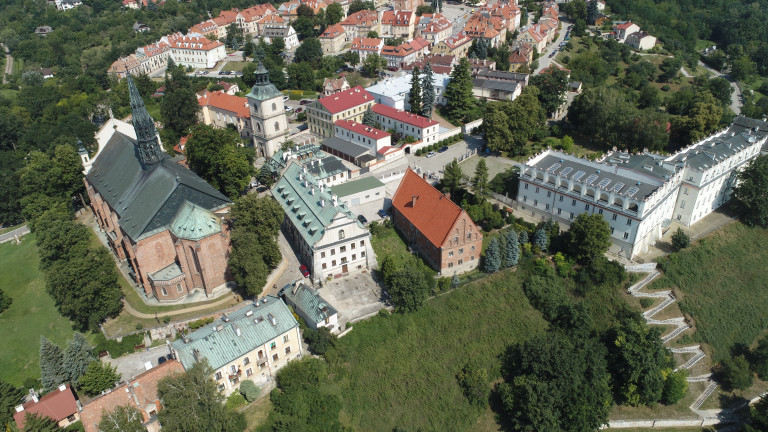
Sandomierz – a Gem of the Świętokrzyskie Region
Sandomierz is one of the oldest and most historically meaningful cities in Poland. Due to its rich history, the whole Sandomierz is a kind of an outdoor museum where every epoch has left its mark. There are over 120 historic buildings, which, together with the beautiful landscape and picturesque location, make Sandomierz an exceptionally attractive tourist site.
The Town Hall – built in the 14th C., it initially had a form of tower. Due to a rebuilding in the 15th C., the structure got the shape of a lengthened rectangle. A century later, it got a high attic, decking the whole roof, and in the beginning of the 17th C. a tower was added on the western side. The tower is now plastered, has an arcade entrance to the ground-floor rooms and brass roofing with a figure of an eagle from the times of Duchy of Warsaw (Księstwo Warszawskie) on the top. The building went through several fires, mainly in 1623 and 1757, yet luckily it is made of brick, so the construction has not been completely damaged. Moreover, a spacious cellar, mentioned in Fr. M. Buliński “Monografia”(“Monograph”), has been lately discovered under the building. The room could have been used as prison where the accused were tortured, as there are hooks and rings attached to the walls. Yet, these are not only remarkable elements of this object. In another part of the building, there is a residence of the Regional Museum with historic and artistic exhibitions, e.g. a collection of documents and city seals, among which there is a location act of Leszek Czarny (Leszek the Black) from 1286, and a chess set from ca. 12-13th C. The Town Hall’s interiors are also noteworthy because of the late-Renaissance, neo-Renaissance and neo-Baroque furniture. The historic department of the museum covers the ground floor of the building, while on the first floor there is a wedding hall and the rooms of the City Council. In the basement one can find “Lapidarium” (“The Lapidary”), a club of the Sandomierz Cultural Society.
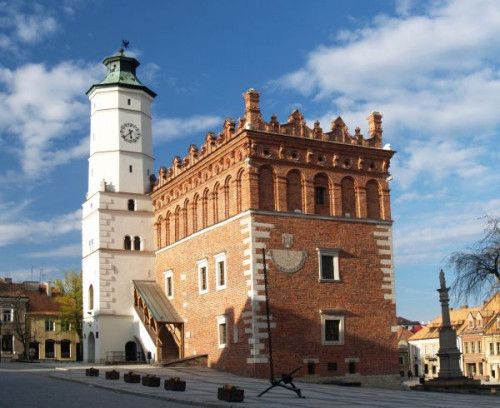
Collegium Gostomianum – erected in the beginning of the 17th century, it preserved its initial function and architectural shape. Collegium is one of the oldest high schools in Poland, there is even an original wing of the Jesuit building, founded in 1602 by Hieronim Gostomski – the voivod of Poznań and the Sandomierz castellan. The rest of the complex had been erected between 1604 and 1615 by a Jesuit builder Michał Hitz, unfortunately, the fires in 1656 and 1813 damaged it considerably. In the second half of the 19th century the southern wing and the St. Peter’s Church, situated in the middle of the courtyard, were deconstructed. Later archeological research proved that in their place there had previously been a medieval settlement and after that a cemetery. The six-storey object still has the original spatial arrangement, vaulting decorations, heating system, and, on two levels, an elliptic stairway, unique on the scale of the whole country. Underneath the structure there is a spacious two-level basement. Like in the past, nowadays Collegium Gostomianum is a school building.
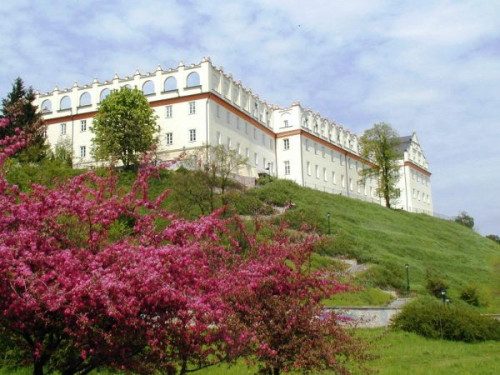
The Długosz House – it is one of the best preserved gothic housing estates. Today, it houses a rich collection of the Diocese Museum. It was founded in 1476 by a historian named Jan Długosz – a Sandomierz canon for the mansionary clerics (vicars of the cathedral). In 1864 the house went under the administration of the cathedral chapter. It is a two-level, brick building with high pinnacles and a gable roof. Over the southern entrance you can see a stone erection board with the Wieniawa coat of arms, an inscription and a date “1476.” Inside there is a remarkable vestibule and beam ceiling, yet the arrangement of the interiors was partly modified to meet the demands of the present museum, which has resided here since 1937. The author of its first exhibition was Karol Estreicher, an art historian from Cracow. Now, it is in possession of valuable collections of paintings, sacred sculpture, tapestry, fine arts, ceramic, furniture, numismatics, decorative art, architecture elements and archeological objects.
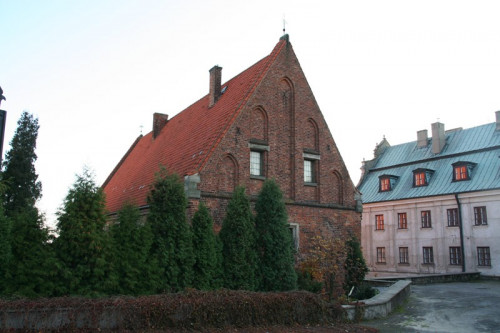
The cathedral – erected in the 14th century, it has the original spatial arrangement and elaborative sculptural ornamentation. The inside decor comes from a period between the 15th and 17th C. – these are mostly the Byzantine-Ruthenian frescos and Rococo altars, paintings and sculptures. The cathedral basilica was built in the place of the previous Romanesque collegiate, destroyed during the invasions of Tatars in the 13th century and Lithuanians in 1349. In 1360, king Kazimierz Wielki (Casimir III the Great) founded a new collegiate which, together with the foundation of the Sandomierz Diocese, gained the dignity of a cathedral in 1818 and in 1960 it became a cathedral basilica. It is a Gothic hall-church with a closed, three-sided and lengthened presbytery, and lierne ribbed vault. On the walls there are polychromes from ca. 1421, made by a Prussian workshop of the master craftsman Hayl from Przemyśl, the frescos were discovered and conserved between 1934-1936. The altars and portals of the cathedral are made of black marble and decorated with pink marble elements, which is a unique example of stonework of the workshops from Czarna near Cracow in the 17th and 18th C. What is more, inside, by the pillars between naves, there is a complex of Rococo altars from the late 18th C. It is the work of a famous workshop of Maciej Polejowski from Lvov. You should also see a set of 16 paintings, 12 of which makes the, so called, “Kalendarium”(“Calendar”), while the remaining 4, located beneath the choir, depict scenes from the history of Sandomierz: martyrdom of the Sandomierz citizens in 1260, martyrdom of the Dominicans in 1260, a ritual Jewish murder, and the Swedish detonation of the castle in 1656. The latter shows a legendary story, when the knight Bobola was swept by a wind-blow and carried over the Vistula without any injury. In the cathedral treasury there are also numerous incunables and a reliquary of the Holly Cross Wood, donated by king Władysław Jagiełło in recognition of the merits of the Sandomierz knighthood in the Battle of Grunwald.
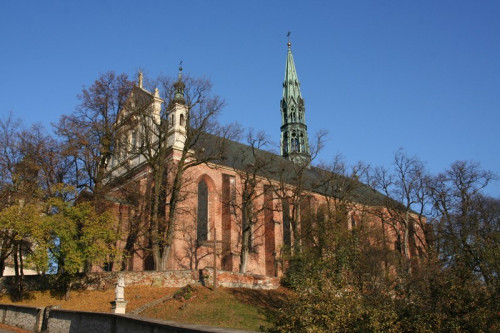
The castle – it was built in the 14th C. in the place of a former fortress, which probably had been existent there at least since the 10th C. In 1139 Sandomierz became a capital city of the principal districts and, as a prince’s residence, the castle must have been expanded. Therefore, the burgh was surrounded with a rampart, made of earth and wood, a system of abates from diagonally impaled stakes and a moat on the side of the slope. Firstly, it had been a castellany and on the break of the 12th and 13th C. it became a capital of the principal district. In the 14th century king Kazimierz Wielki (Casimir the Great) used the location to built a stone castle. Probably at that time, it was attached to the city walls, while the south-eastern tower, which dominates over the street, was added in 1480. In 1525, according to the design of Benedict of Sandomierz, the castle was turned into a Renaissance residence. Later it was rebuilt several times under the supervision of a famous architect and sculptor Santo Gucci. At that time, it had four wings surrounding a columned yard. Unfortunately, in 1656 it was blown up by the withdrawing Swedes and only one wing remained. Since the mid-17th C., the castle was no longer an official residence either for the kings or for the Sandomierz prefects and it became a public utility object. After 1795 the Austrians turned it into a court and a prison and surrounded the yard with a semicircular wall. Fortunately, an old well on the yard and the remains of king Casimir’s castle foundations, have survived till nowadays. The prison was liquidated in 1959.
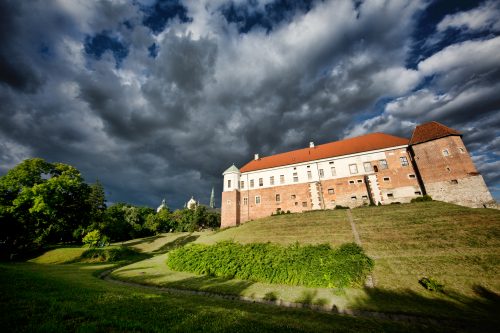
The Dominicans’ Monastery Complex by St. Jacob’s Church – it is a late-Romanesque site, built in 1226, which preserved the typical spatial arrangement of a monastic building and the rich ornamentation made of baked and glazed brick. It is the oldest and most valuable monument of Sandomierz and, at the same time, one of the first brick churches in Poland. Therefore, it has been classified as a monument of the highest value. The hill, on which it is located, is called “Świętojakubowskie” (St. Jacob’s) or “Staromiejskie” (Old Town’s). For several centuries, it was intensively colonised – between 10th and 13th C. there had even been a prosperous settlement with a market and in the end of the 12th C. duchess Adelajda (Adelaide) founded a temple in here. On its place, by generosity of Iwo Odrowąż, the Dominicans built the today’s monastery and settled in Sandomierz. The church was erected as a three-nave basilica with a lengthened, three-arched presbytery. The complex includes several sites: two wings of the monastery (attached to the church) – unfortunately they are only partly preserved, a campanile from 1314, and a chapel from the mid-!7th century, devoted to the Sandomierz martyrs. Its late-Romanesque ceramic ornamentation of the elevation, the northern portal in particular, is one of the most beautiful in the whole country. Inside the church, there are several valuable and noteworthy elements: the wings of the former main altar from 1559, the stuccowork on the vaulting of the presbytery and the Chapel of Martyrs from the 17th C., as well as, beautiful stained-glass windows, designed by Karol Frycz, from 1910-1918.
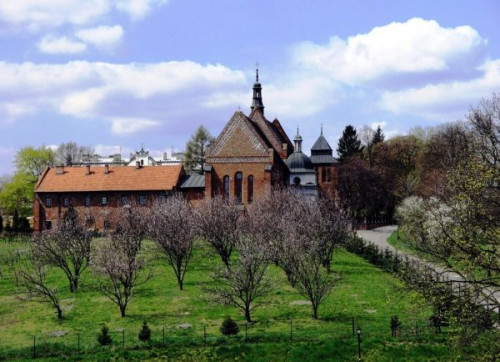
The Church of St. Michael – together with the Benedictine Sisters’ monastery, it was built in the 17th C. by generosity of Zofia Wieniawska, according to the design of Michał Link. The church has one nave and a barrel vaulting, supported by doubled Ionic pilasters. The decor of the temple is worth attention mostly for: an ambo in the form of a tree growing out of the lying figure of St. Benedict (a genealogic lineage of the Benedictine Order) – designed by Mateusz Roskwitowicz in the 17th C., two side altars from the same period, as well as stalls and pews made in the workshop of Marcin Czarny.
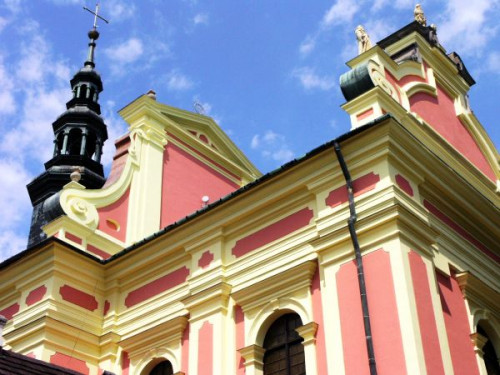
The Church of St. Paul – one of the oldest churches in Sandomierz, it was erected between 1426 and 1434 in the place of a wooden church founded by the Cracow bishop Iwo Odrowąż in 1226. In the 17th and 18th C. the temple was enlarged and rebuilt, therefore, today it is a mix of several styles: Gothic, Renaissance and Baroque. Nevertheless, inside the furnishing is homogenous and beautiful, especially the richly gold-plated polychrome altars, stalls, the ambo, the choir and the decor of the St. Barbara’s Chapel.
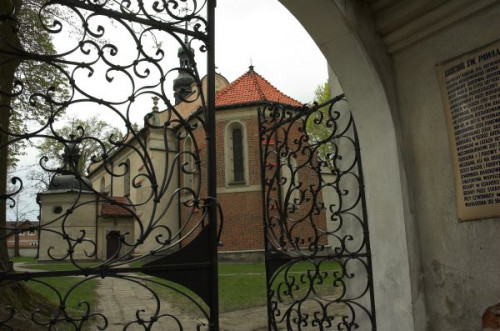
The Bishops’ Palace – built between 1861 and 1864, made of the materials from deconstruction of St. Mary Magdalene’s Church and St. Paul’s Church. The ground floor is mostly occupied by office rooms of the diocese curia, while on the first floor there are the rooms of the Sandomierz Bishop Ordinary.
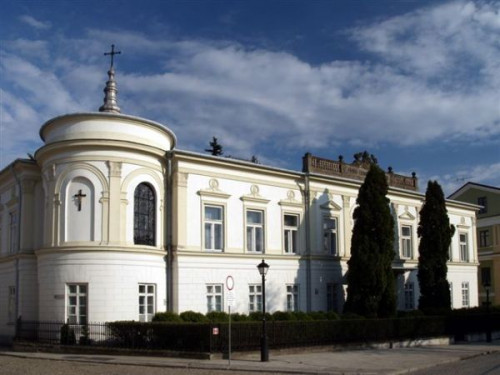
The Opatów Gate – built between 14th and 16th century. It is one of the best preserved city gates in Poland. Initially, in the system of the Sandomierz wall fortifications there had been four gates of such type: the Zawichost Gate and the Opatów Gate in the north, the Cracow Gate in the south and the Lublin Gate in the east. In the 15th C. the Opatów Gate was heightened and topped with a renaissance attic. From a 30 metres high tower you can see a fantastic view of the city and its surrounding. It is worth mentioning that originally the particular levels of the tower were connected by ladders and platforms which enabled access to the shooting-holes. The entrance of the gate could be closed with an iron grate and on the northern wall of the tower there is till a slide, on which it was either lowered or raised.
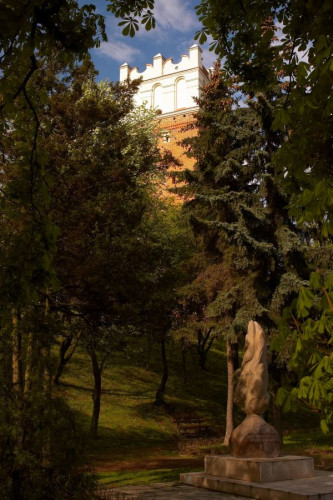
The Dominican Gate – it comes from the 15th C. and is commonly known as “Ucho Igielne” (“the Needle’s Eye”), because of its characteristic shape. It is a wicket in the city walls which enabled entering the area of the city not only for the monks, but also other men, for whom the gates of Sandomierz had officially been closed.
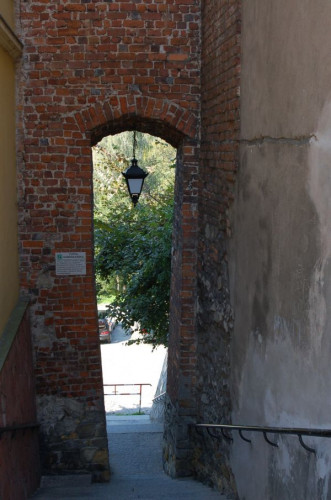
The Underground Tourist Track – it is a part of a multilevel complex of chambers and galleries outside the city. The structure had been cavered for economical and defence purposes and for centuries it has been a mystery. According to the legend, Halina Krępianka heroically died in here, when she was escaping the Tatars. At war, the city defenders used these corridors during their forays outside the city walls to hit straight on the enemy’s troops. The Sandomierz undergrounds are also evidence of the former splendour of the city – the multilevel cellars under the tenement houses near the Town Square were a property of rich merchants, winery owners and apothecaries. Nevertheless, the undergrounds, which had been a shelter for the citizens during certain turbulent events, were also a reason for many building accidents. Therefore, in the 60s and 70s of the 20th C., during the Old Town restoration plan, most underground caverns were identified and secured. In 1977 The Underground Tourist Track was officially opened for the tourists. The overall length of the track is around 470 metres, the deepest chamber is situated 12 metres below the surface. The present names of particular chambers refer to the history and legends concerning the city.
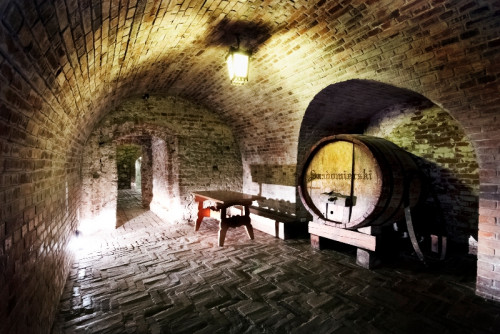
The Ravine of Queen Jadwiga – a natural, loess ravine, ca. 500 metres long and up to 10 metres deep. It separates the Świętojakubskie (St. Jacob’s) and Świętopawelskie (St. Paul’s) hills.
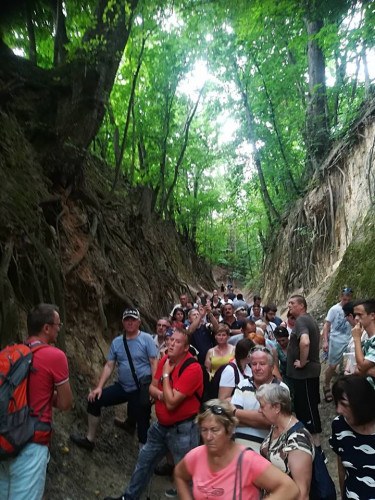
One of the latest Sandomierz attraction is the newly renovated “Piszczele Park,” where there are such interesting objects as: walking and bicycle paths, a skate park, several grass sport fields, one asphalt basketball field, bowers and, at the top of Polana Słoneczna (Sunny Glade), there is a Green Culture Centre with a mini-skilift in the winter.



